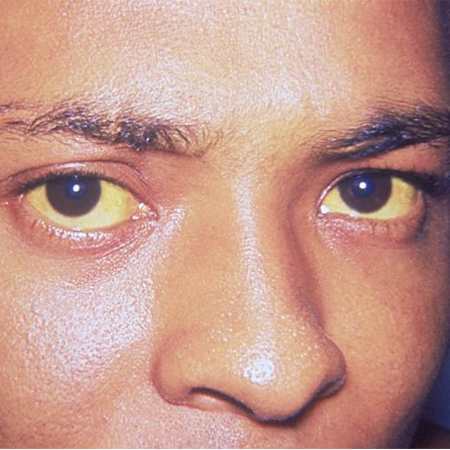History and exam
Key diagnostic factors
common
fever
Often abrupt-onset and before the patient has jaundice.
malaise
Often abrupt-onset and before the patient has jaundice.
nausea and vomiting
Often abrupt-onset and before the patient has jaundice.
jaundice
Occurs in about 70% to 80% of symptomatic adult patients.[38] Typically peaks 2 weeks after infection. Only 10% of infected children develop jaundice.[33][Figure caption and citation for the preceding image starts]: Hepatitis A infection manifested here as jaundice of the conjunctivae and facial skinCDC/ Dr. Thomas F. Sellers/Emory University; used with permission [Citation ends].
hepatomegaly
Occurs in about 70% to 80% of symptomatic patients.[38] Often occurs with right upper quadrant pain.
right upper quadrant pain
Often occurs with tender hepatomegaly.
clay-colored stools
Stools are acholic, giving rise to a clay color.
Other diagnostic factors
common
fatigue
Often abrupt-onset and before the patient has jaundice.
headache
Often abrupt-onset and before the patient has jaundice.
dark urine
A feature of the icteric phase.
pruritus
A feature of the icteric phase.
uncommon
arthralgias and myalgias
Extrahepatic features may be evident.
cough
Extrahepatic features may be evident.
diarrhea
May be a feature of the preicteric phase.
constipation
May be a feature of the preicteric phase.
splenomegaly
Possible physical sign on abdominal examination.
posterior cervical lymphadenopathy
May be detected on examination.
evanescent rash
Nonspecific feature.
bradycardia
May be detected on examination.
Risk factors
strong
living in endemic region
In developing countries with poor sanitation >90% of children are infected before 10 years of age.[10]
travel to endemic region
Unvaccinated people from developed countries who travel to areas of high or intermediate hepatitis A endemicity have a significant risk for acquiring hepatitis A.[21]
Risk is highest for people who live in or visit rural areas, frequently eat and drink in places with poor sanitation, or trek in backcountry areas.[21]
close personal contact with an infected person
men who have sex with men
known foodborne outbreak
Foods associated with outbreaks are typically eaten raw, and include fruits, vegetables, and shellfish.[21] The disease may also be acquired by direct contact with contaminated water or ice (including shellfish harvested from sewage-contaminated water), from contaminated frozen foods, or from foods contaminated by infected food handlers.[22][23]
illegal drug use
The number of cases of hepatitis A virus infection associated with injection drug use in the US has increased rapidly since 2015. Injection drug use is the most commonly reported risk factor in the US.[13]
homelessness
The number of cases of hepatitis A virus infection associated with homelessness in the US has increased rapidly since 2015.[13]
weak
occupational exposure
People who work in research laboratories handling hepatitis A-infected material, and people who work with nonhuman primates, are at risk of occupational infection. Healthcare workers and workers exposed to sewage are not at significantly increased risk.[21]
Use of this content is subject to our disclaimer